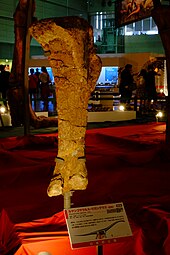
Titanosaurs were a diverse group of sauropod dinosaurs, including genera from all seven continents. The titanosaurs were the last surviving group of long-necked sauropods, with taxa still thriving at the time of the extinction event at the end of the Cretaceous. This group includes some of the largest land animals known to have ever existed, such as Patagotitan—estimated at 37 m (121 ft) long with a weight of 69 tonnes —and the comparably-sized Argentinosaurus and Puertasaurus from the same region.
Agustinia is a genus of sauropod dinosaur from the Early Cretaceous of South America. The genus contains a single species, Agustinia ligabuei, known from a single specimen that was recovered from the Lohan Cura Formation of Neuquén Province in Argentina. It lived about 116–108 million years ago, in the Aptian–Albian stages of the Early Cretaceous Period.

Euhelopus is a genus of sauropod dinosaur that lived between 145 and 133 million years ago during the Berriasian and Valanginian stages of the Early Cretaceous in what is now Shandong Province in China. It was a large quadrupedal herbivore. Like sauropods such as brachiosaurs and titanosaurs, Euhelopus had longer forelegs than hind legs. This discovery was paleontologically significant because it represented the first dinosaur scientifically investigated from China: seen in 1913, rediscovered in 1922, and excavated in 1923 and studied by T'an during the same year. Unlike most sauropod specimens, it has a relatively complete skull.

Andesaurus is a genus of basal titanosaurian sauropod dinosaur which existed during the middle of the Cretaceous Period in South America. Like most sauropods, belonging to one of the largest animals ever to walk the Earth, it would have had a small head on the end of a long neck and an equally long tail.
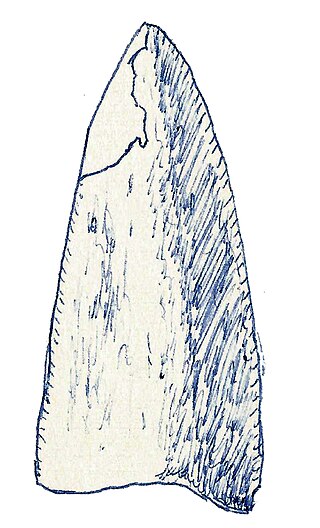
Mongolosaurus is a genus of titanosauriform sauropod dinosaur which lived during the Early Cretaceous of China.

Phuwiangosaurus is a genus of titanosaur dinosaur from the Early Cretaceous (Valanginian-Hauterivian) Sao Khua Formation of Thailand. The type species, P. sirindhornae, was described by Martin, Buffetaut, and Suteethorn in a 1993 press release and was formally named in 1994. The species was named to honor Princess Maha Chakri Sirindhorn of Thailand, who was interested in the geology and palaeontology of Thailand, while the genus was named after the Phu Wiang area, where the fossil was discovered.
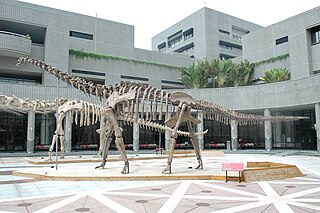
Huanghetitan, is a genus of sauropod dinosaur from the early Cretaceous Period. It was a basal titanosauriform which lived in what is now Gansu, China.

Zhongyuansaurus is a monospecific genus of ankylosaurid dinosaur from Henan that lived during the Early Cretaceous in what is now the Haoling Formation. Zhongyuansaurus is possibly a junior synonym of Gobisaurus, a basal ankylosaurid from the Ulansuhai Formation of Inner Mongolia.

Dongyangosaurus is a genus of titanosaurian sauropod dinosaur from the Late Cretaceous. The only species is Dongyangosaurus sinensis, from which only a single fragmentary skeleton is known, coming from the Zhejiang province of eastern China. It was described and named by Lü Junchang and colleagues. Like other sauropods, Dongyangosaurus would have been a large quadrupedal herbivore.
Malarguesaurus is a genus of titanosauriform sauropod dinosaur from the Late Cretaceous of Mendoza Province, Argentina. Its fossils, consisting of tail vertebrae, chevrons, ribs, and limb bones, were found in the upper Turonian-lower Coniacian Portezuelo Formation of the Neuquén Group. The type species, described by González Riga et al. in 2008, is M. florenciae.
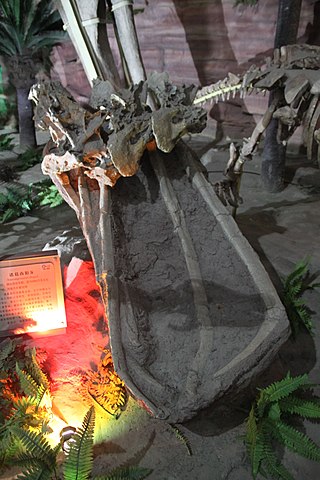
Baotianmansaurus is a genus of titanosaur sauropod dinosaur. Its fossils have been found in Upper Cretaceous rocks in Henan, China, within the Gaogou Formation. The type species is B. henanensis, described in 2009. The holotype is 41H III-0200. Remains of the fossils were vertebrae, ribs and scapula fragments. It was probably a close relative of Opisthocoelicaudia and Dongyangosaurus in Saltasauridae.

Wintonotitan is a genus of titanosauriform dinosaur from Cenomanian -age Winton Formation of Australia. It is known from partial postcranial remains.
The Haoling Formation is a Mesozoic geologic formation in the Ruyang Basin of Henan, Province, central China. Dinosaur remains are among the fossils that have been recovered from the formation.
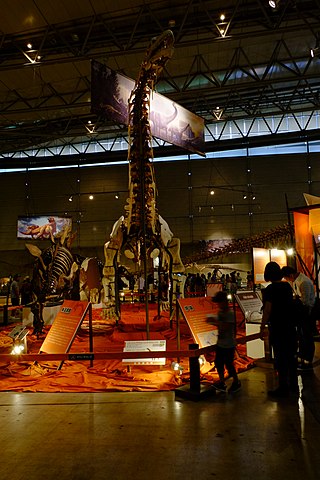
Xianshanosaurus is a genus of sauropod dinosaur from the Early Cretaceous (Aptian-Albian) of the Ruyang Basin in Henan Province, China. Its type and only species is Xianshanosaurus shijiagouensis. It was described in 2009 by a team of paleontologists led by Lü Junchang. Xianshanosaurus may be a titanosaur, and Daxiatitan may be its closest relative, but its evolutionary relationships remain controversial.
Yunmenglong is an extinct genus of somphospondylan sauropod known from the late Early Cretaceous of Henan Province, central China. Its remains were discovered in the Haoling Formation of the Ruyang Basin. The type species is Yunmenglong ruyangensis, described in 2013 by Junchang Lü et al. on the basis of an incomplete postcranial skeleton. Yunmenglong shares some characters with Euhelopus, Qiaowanlong and Erketu, and a phylogenetic analysis places it as a sister taxon of Qiaowanlong, both grouped with Erketu in a position more derived than Euhelopus but basal to Titanosauria.

Yongjinglong is an extinct genus of titanosauriform sauropod dinosaur known from the Early Cretaceous of Lanzhou-Minhe Basin of Gansu Province, China. It contains a single species, Yongjinglong datangi.
Triunfosaurus is a genus of somphospondylan sauropod dinosaur from the Early Cretaceous of Brazil. It contains a single species, T. leonardii, described by Carvalho et al. in 2017. As a genus, Triunfosaurus can be distinguished from all other titanosaurs by the unique proportions of its ischium. It was initially described as a basal titanosaur, making it the earliest basal titanosaur known; however, subsequent research questioned the identification of the taxon as a titanosaur, instead reassigning it to the Somphospondyli.

Diamantinasauria is an extinct clade of somphospondylan titanosauriform sauropod dinosaurs with close affinities to the Titanosauria, known from the early Late Cretaceous (Cenomanian-Turonian) of South America and Australia. It was named by Poropat and colleagues in 2021, and contains four genera: Australotitan, Savannasaurus and Diamantinasaurus from the Winton Formation of Queensland, as well as Sarmientosaurus from the Bajo Barreal Formation of Patagonia. The existence of the clade indicates connectivity between Australia and South America via Antarctica during the Cretaceous period.
Ruixinia is an extinct genus of somphospondylan titanosauriform dinosaur from the Early Cretaceous (Barremian) Yixian Formation of China. The genus contains a single species, Ruixinia zhangi. The Ruixinia holotype is a partial articulated skeleton with the most complete series of caudal vertebrae known from any Asian titanosauriform.




